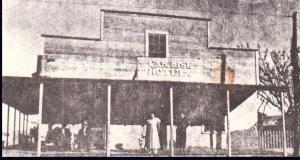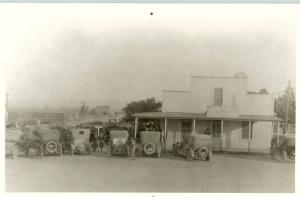Cochise Hotel, Westward, Ho!
Cochise, Arizona was a railroad town. The hotel was not only a place for folks to stay and grab a bite to eat, it was the first water well in an area where water was scarce and precious. Women came from miles around to wash their household clothing in the Cochise laundry. The Hotel’s well supplied the Union Pacific Railroad locomotives that puffed their way through the town, stopping there to take on water and more fuel.
Arizona was a wild place in those days. The unincorporated town of Cochise and Cochise County take their name from the Apache Chief, Cochise. The town is located not far from Tombstone, where the Wyatt Earp and brothers with Doc Holiday had their famous shoot-out at the OK Corral. Big Nose Kate, Doc Holiday’s girl-friend worked in the hotel. Local law-men were not very well paid, so one of them – Burt Alvord and his friend Billy Stiles, took up train-robbing to supplement their income. They forced the crew off the train at Cochise, and blew up the safe. The escapade proved their undoing, however, because one of the gang was wounded and left behind for the posse. He was subsequently taken to jail in Tombstone, and confessed before his death, naming his partners in crime.
But the wild days of steam trains soon came to an end. In the early 1900s, the United States began using diesel trains, instead. Since the diesel locomotives did not require water or the kind of refueling needed by steam engines, towns like Cochise were no longer regular train stops. The population of the town dwindled, the hotel was sold, then resold, falling into a state of disrepair. Elizabeth Husband purchased the building in 1958, and kept the hotel open until her death in 2002. It was subsequently purchased by film-maker Philip Gessert, who began setting the grand old building to rights.
Restoration of the Cochise Hotel doesn’t qualify as a tax-deductible restoration, so Gessert plans to resurrect her as a B&B and museum. But it takes a lot of money to turn an historic building into something modern enough to function as a 21st century accommodation. A new well needs to be drilled, the plumbing completely redone for all ten bathrooms, the kitchen repaired and modernized. Even the thick adobe that comprises the walls needs to be repaired, and new paint is needed just about everywhere. Gessert has sunk as much of their personal funds into the project as they dare, so they need the help from the community of people who love the legends of the wild days of the west.
Anyone who makes a contribution – however great or small – will be acknowledged on the website, and they will receive an electronic certificate of appreciation. Rewards for larger contributions include t-shirts, a free night’s stay in the hotel, or a weekend stay, and a plaque displayed in the hotel. If you love the idea of restoring this old Grand Dame of the west, but haven’t any cash, spread the word about the Indiegogo crowdfunding campaign and the restoration of this historic landmark on social media sites and just by mentioning it to friends and neighbors. The more people who know about the restoration, the better chance there is of raising enough money for the repairs.
If you happen to be in the neighborhood, bring your work gloves and pitch in. The Gesserts are doing their best to re-create the excitement and grandeur that once bloomed in the middle of the desert – including the lovely backyard garden that once grew behind the hotel. They’ve already put a lot of work into it, and Phillip has brought his own collection of antiques to use as furnishings. But without restoration, this once lovely lady of the desert will crumble away, and all that will be left is the rusted water tank, the coyotes, and the wind.
About: Phillip Gessert is a writer specializing in western history and film maker. He also makes turn of the century gambling equipment, and is a noted Faro dealer. He helped create the documentary, “American Songwriter” which won several awards recently. Phillip currently resides in the Cochise Hotel while working to restore it whenever he is not on location editing a film project.
Phillip Gessert
Cochise Hotel
www.cochisehotel.net
email us here
Legal Disclaimer:
EIN Presswire provides this news content "as is" without warranty of any kind. We do not accept any responsibility or liability for the accuracy, content, images, videos, licenses, completeness, legality, or reliability of the information contained in this article. If you have any complaints or copyright issues related to this article, kindly contact the author above.


